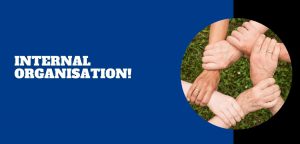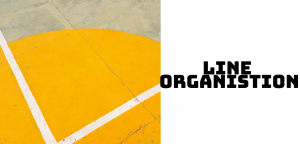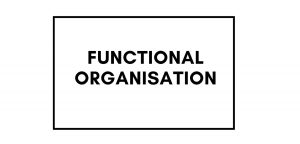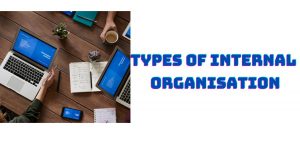Internal Organisation Structure

The word organization originated from the word ‘Organism’ which implies the structure of interrelated parts.
The organizational structure is designed to clarify who is to do what and who is responsible for the work in the Organisation.
It is worked on a central concept design for the employee to be in the right place at work.
According to Louis Allen, “Organization is the process of identifying and grouping work to be performed, defining and delegating responsibility and authority and establishing relationships for the purpose of enabling people to work most effectively together in accomplishing objectives.” In the words of Allen, the organization is an instrument for achieving organizational goals. The work of each and every person is defined and authority and responsibility are fixed for accomplishing the same.
Authority and responsibility of each position are defined in the Organisational structure.
Starting a business at a right time, right place with the right people is the essential thing to see the success path in business life. The External and Internal environment helps the organization to focus on success.
The Internal Organisation structure helps the new entrepreneur to Identify the style of the organization. The Internal Organisation represents the connection between horizontal and vertical relationships between various positions. It also depends upon nature, objective, mission, the vision of the particular enterprise.
According to Wheeler, “Internal organization is the structural framework of duties and responsibilities required of personnel in performing various functions within the company. It is essentially a blueprint for action resulting in a mechanism for carrying out function to achieve the goals set up by company management”. In Wheeler’s view, the organization is a process of fixing the duties and responsibilities of persons in an enterprise so that business goals are achieved.
Type of Internal Organisation
- Line Organisation
- Line and staff Organisation
- Functional Organisation
- Committee Organisation
- Task Force Organisation
Line Organisation

It is the oldest form of organization. It is also known as scalar and military organization. It is a vertical line of the organization running from top to bottom. The person at the top will get the highest authority.
The person will be accountable to only one superior. We have two types of Line organization, they are:
- Pure line organization: The members will be grouped together and all members will get the same level of assignments.
- Departmental line organization: Different type of world performed in different departments
Advantage of Line Organisation:
- It is simple and basic because the structure is one single line
- Unity of command is possible, one person will have only one superior
- Easy to navigate for small entrepreneurs
- It is very economical for startups
- Authority and responsibility are clearly defined
Disadvantage of Line Organisation:
- Overburden because the executive is responsible for planning and execution.
- Subordinates cannot express the opinion because the communication must be from upwards.
- Monopoly decisions: only one person can decide for the whole organization.
- Two heads are always better than one
- Instability because of overburden and monopoly.
Functional Organisation:

Functional Organisation is based on the concept of “Functional Foremanship” Developed by F.W. Taylor. He suggested that there must be eight Leaders (rather than one foreman) to guide the employees. Four of them must concern about planning the work and another four must work towards the execution of the plan.
The organization should divide according to their talent and interests, the function is managed by an expert in that area.
The worker in the organization receives instructions from several functional heads.
Advantage of Functional Organisation
- Control: Control will be good in the functional organization as there are specialized employees
- Standardization: Standardization is possible in the functional authority
- Reduction of workload: Every functional head will look at their specialized part so, they divide the work and reduce the workload
Disadvantages of Functional Organisation:
- The command from various specialization will create confusion
- Delay in decision making because of too many heads to decide
- There will be no such thing called co-ordination because of ego, power, and domination among the superiors.
Line and staff Organisation:

Line and staff organization is the combination of line and functional structure. Line authority will be in the vertical line as it in the line organization.
Staff specialists are attached to line positions to advise the employees. These specialists do not have the power to command their subordinates.
Example: The chief Auditor has authority over accountants in the accounts department. But, he has only advisory relationships with another department like production and sales, etc.
Advantage of Line and Staff Organisation:
- Expert advice: Line managers receive their advice from the staff it will make them think out of the box.
- Quality of decision will be ensured
- Flexible to plan and work it out the decision
Dis-advantage of line and staff organization:
- Line staff conflict: Ego and other issues will arise in the line staff organization
- Ineffective staff: Sometimes staff will not take the issue and company objective seriously
- Confusion: Confusion will arise whether line employees have to make the decision or staffs
Committee Organisation:

A committee is a group of people joins together to decide the solution. It is authorized to deal with a normal and specific activity.
The committee is becoming an important instrument o management in the modern organization.
Types of Committee:
- Advisory or Executive committee: Authority committee can give only advice to the executive committee. The executive committee has the authority to plan an make the decision possible
- Line or staff committee: The line committee co-ordinates with subordinates to execute and control the activities. The staff committee is advisory in nature.
- Standing or ad-hoc committee: The standing committee will be last until the company dissolved. Adhoc company will be functioning only for a specific period of time. After the event, the committee will dissolve itself.
Advantages of committee Organisation:
- Group judgment: Two heads are always better than one in any organization.
- Effective coordination is possible because of the committee structure.
- The experience will be gained by working with various members. Their Outlook and knowledge will get widened
Disadvantage of Committee Organisation:
- Time: Committee Organisation will take a lot of time to form and to make a decision at an important time.
- Divided Responsibility: Every member will be unaccountable so the responsibility will be lacking in the committee organisation
- Misuse of Committee: Some members will dominate the entire committee and led it in another direction and misuse it for their own good. The purpose of the committee will vanish.
Tasks Force

A Task Force means a group of people with different backgrounds will work together until a given period of time. When the task or mission completed the task force will dissolve themselves. A task force will be called when the company got a unique problem and it cannot be solved by individual or department. The task force may be called when the company launches a new product or service. Taskforce can also use fight floods, drought to fight from a new disease like COVID’19.
Advantage of Task Force:
- The unique and unusual problem will be solved.
- The task force will work as training for the managers and for the task force team members.
- The organization will not stress the task force members
Disadvantage of Taskforce:
- Task Force disturbs the function of the organizations.
- Selected Task Force members are considered more superior than non-task force members it will create bias among the members of the organization.
- Taskforce develops independence and it will fail to do its purpose.
- Analyze other companies and your competitors as well.
- Follow your inspiration seek advice to improve the internal organization.
- Take Business Lessons from top CEO’s.
- The organization is a structural framework within which various efforts are coordinated and related to each other.

